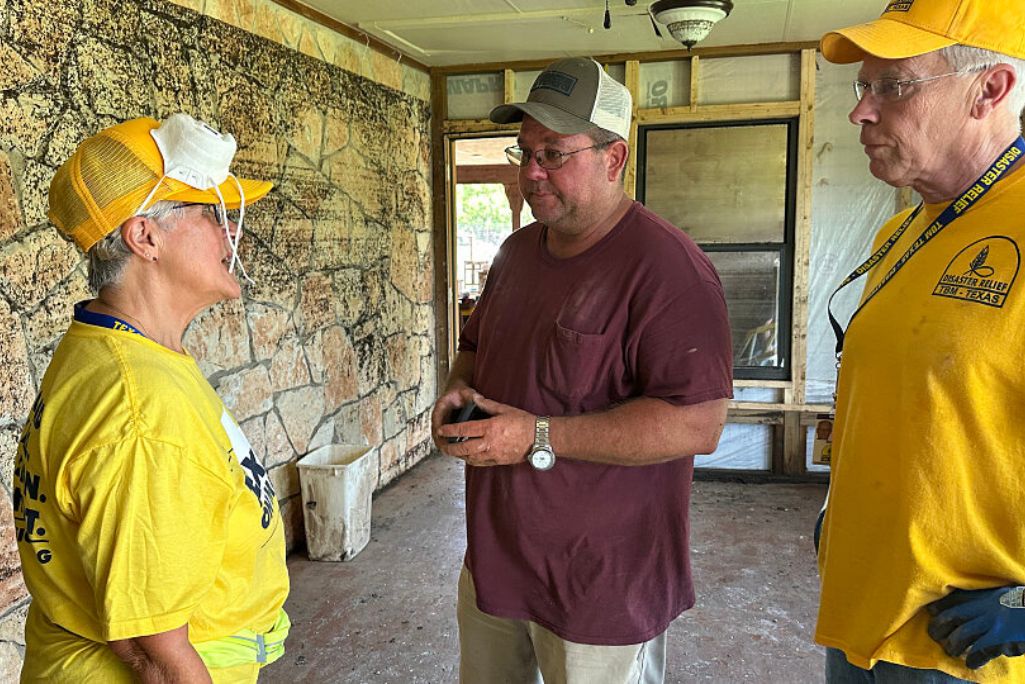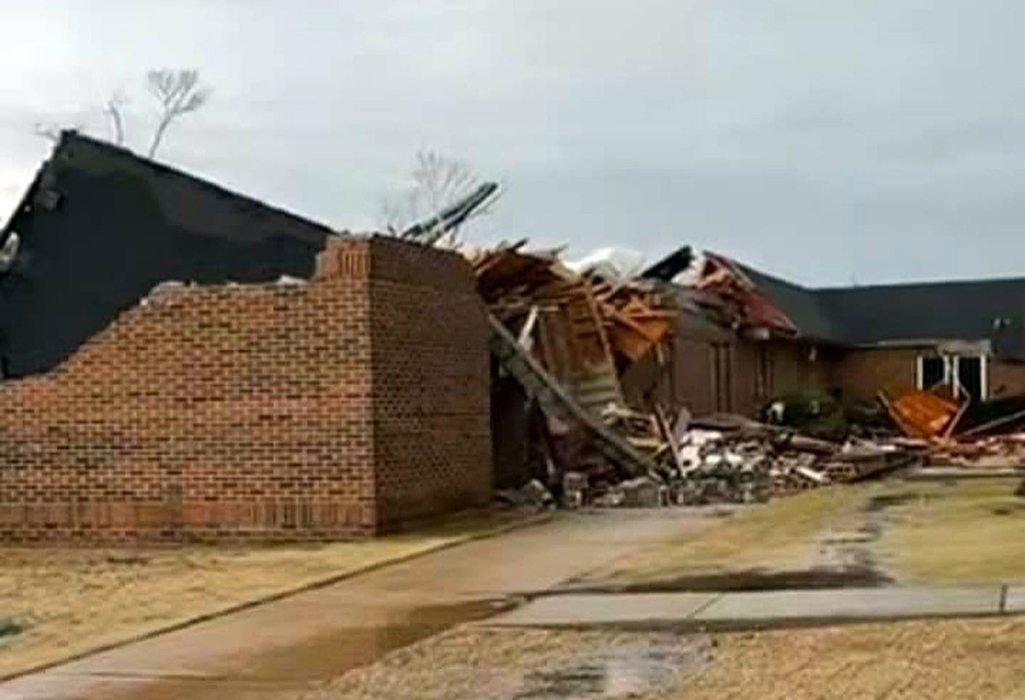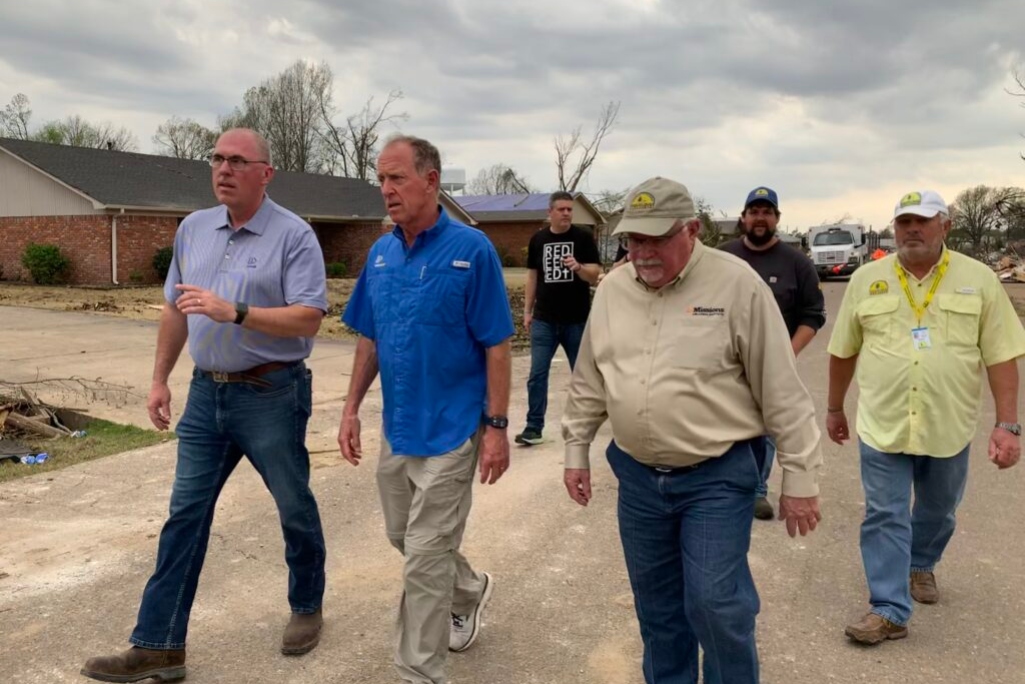
Texans on Mission volunteers visit with John Vlasek in his Hunt, Texas, home.
HUNT, Texas — John Vlasek stands in the middle of his home, stripped bare of furnishings, walls, ceilings and flooring. Even his rock fireplace is gone.
Giving testimony to the height and depth of the floodwaters that destroyed the house on July 4, the waterline can still be seen right below the ceiling.
Surrounding him, Texans on Mission volunteers continue scraping floors and removing nails from studs. They’ve already torn out everything else and are preparing to spray a black mold preventative.
Their work is a critical step that will prepare the Vlasek family for the next phase of their disaster recovery: rebuilding.
As Vlasek stands in the room, a Texans on Mission volunteer comes over and offers a hug in a show of support and love.
“This… all of these volunteers, it means everything to us,” Vlasek said. “I can’t believe they’re here and helping us. I don’t know what …”
Overcome with emotion, he doesn’t finish the sentence. His reaction is common among families here who survived the tragic flood that roared through the area on July 4, leaving 120 people dead and more than 100 still missing.
One of Vlasek’s neighbors noted in passing, “We’re all experiencing some form of PTSD. Every time a helicopter passes by or a door slams, I jump.”
Vlasek, his wife and a son were awakened by the flood as water began entering their home. It was a shock for the area native, who says he’s “never seen the water rise this high.”
The family raced up a hill in their neighborhood to escape the waters.
Working one home over from Vlasek’s, Benny Williams serves as the “blue cap” leader for Texans on Mission’s Marble Falls Disaster Relief, swollen to 30 people from several cities.
His team is providing the mud-out work for the Vlasek family and two of their neighbors.
“We have a large team, and so we split them up, and all of these houses are pretty much complete, total removal on the inside,” Williams said. “The house structure is fine, and it didn’t float off the slab or anything like that, so the houses can be rebuilt.”
In another Hunt neighborhood, Sid Riley and Nathan Buchanan canvassed a small subdivision prior to sending in day volunteers to provide mud-out work in the 10 homes there. Riley is Texans on Mission day volunteers coordinator, and Buchanan is overall volunteer coordinator for the organization.
David Bolduc, Homeowners Association president, said all of the homes in the neighborhood would need mud remediation except for one — his. It was completely swept off its foundation.
Riley said day volunteers provide “synergy” to large deployments.
“They bring a willingness to serve and learn. They are a force multiplier of our trained volunteers that in some cases quadruples our work we can perform in a given time.”
He noted, “Our day volunteers often see their work as an opportunity to demonstrate to others what we have been called to do and often generates a desire to join organizations like ours.”
The work is hot, humid and muddy. The homes in the neighborhood smell like river water, and the mud is still wet. Dark brown waterlines extend past head height in most of them.
The deployment differs from many others. The incredible loss of life has affected most of the survivors, and there’s an air of grief.
And with more than 100 people still listed as missing, it is one of the few times Texans on Mission teams have had to work in an active search and recovery zone.
One team member noted that an assessor team had to wait for law enforcement to clear a home they were assessing. The authorities located and removed a body in the mud before assessors were allowed in to do their work.
Chaplains speak hope to survivors, responders
Texans on Mission chaplains have rarely felt more needed. Chaplain Paul James worked with one survivor who “was very distraught because they had lost everything in the house, and everything was flooded.
“As soon as I started talking to him, …he just started weeping,” James said.
The man was “a burly guy and his two sons and his daughter-in-law were there helping him. …He was getting the support from his family that he needed, but it was an overwhelming task.
“We prayed with him and at the end of the day he was much better,” James said. “But this isn’t about us chaplains. It’s also the way that everybody here loves. It really makes my job easy as a chaplain because (survivors) look at everybody and know they really care about them, and they’re wanting to lift the burden and give them some hope.
“And so by the end of the day today, that particular family was really experiencing hope,” James said. “They were joyful, and (we) got to pray with them.”
Texans on Mission’s Stacie Meeks said chaplain teams also ministered to first responders, many of whom were already physically and emotionally exhausted.
“I asked one of them, ‘How’re you doing today?’ He said he was fine, but I asked again: ‘No, seriously. How’re you doing today?’
“We talked, and I delved a little further,” she recalled. “And then he had a story to tell. He talked about how he felt insignificant.”
After Meeks inquired why, he responded that “he was wasting his time,” and his efforts “didn’t matter.”
“He said, ‘Yesterday we had a chance to really make a difference on the river. And today, not so much.’
“And I told him, ‘Your time matters. You made a difference. You’re here for a purpose. What you do matters for these people in this community.’”
Meeks said the team “encountered many, many people experiencing the same emotions. They hurt, and these people are exhausted. …They’re exhausted, hot, tired.
“That’s when they need us speaking about the hope of Christ the most,” she said.
(EDITOR’S NOTE — This article originally appeared at texansonmission.org.)


